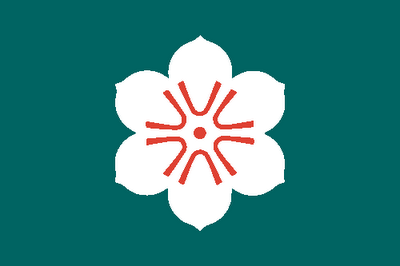It's positively a great flag! I like too much radial symmetry in flags, and it's a great example of it. It's simple, everybody could easily guard all details in memory and after all reproduce them. The flag represents camphor flower, in format of mon (see definition below). The white color represents justice, while red is for passion and loyalty. As a whole, the flag represents "a highly developing harmony".
A "mon" is a stylized figure used as familiar or personal insignia, similarly to Western crests and badges. Click here to confer a gallery of mons.
Now, I'll show the beautiful Fukui prefecture flag, that'll be used to explain other tradition on Japanese flags.
This flag is very colorful, isn't it? Japanese flags are very colorful, usually bicolor or tricolor. Every color can be used in Japanese flags, including some tones that are rare in West, like grey, brown, purple, teal, buff, brownish-green and rose color.
You may be asking yourself "What's this symbol?". This mon is a stylized version of Fukui name transcription in katakana ("フクイ"). A very common technique on these flags is use the name of the entity (or their first syllables) and stylize it as a mon.
I hope you liked the flags and the text. Your comment is welcome, and you're free to ask, suggest, praise, criticize or give your opinion.



